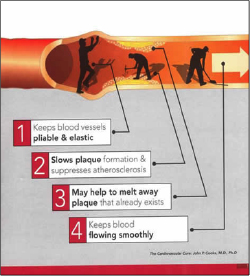Ozone therapy in atherosclerotic disorders (Part one)

Diseases related to atherosclerotic disorders:
- Ischemic heart disease
- Discirculatory encephalopathy
- Obliterating endarteritis
Mechanism of action:
- Activates the antioxidant system, especially the enzymatic one (superoxide dismutase, catalase, glutathione) and in this way eliminates the toxicity of lipoproteins (free radicals).
- Activates metabolism in erythrocytes and improves oxygen delivery to tissues. Also increases the elasticity of erythrocytes, thus improving the rheological properties of the blood.
- Normalizes hemostasis by reducing platelet aggregation, increasing fibrinolytic activity, and reducing fibrinogen. It should be noted that the hypocoagulant action occurs only in cases of coagulation disorders and is manifested by a shift in average values towards the lower limit of the norm.
- The anti-inflammatory action leads to the stabilization of the atheromatous plaque.
In CHD, ozone therapy should be accompanied by conventional treatment, while in the other two disorders it can also be used as monotherapy.
Use of ozone in ischemic heart disease
As mentioned above, ozone therapy in this disease is used only as complementary therapy. It is applied systemically by one of the following methods: ozonated physiological solution, rectal insufflation or major autohemotherapy. A total of 8-10 sessions.
Positive results are seen in the reduction of cardiac attacks, an increase in exercise tolerance, and a decrease in the atherogenic coefficient.
Use of ozone in obliterating endarteritis
This is the classic indication for ozone therapy. As known, obliterating endarteritis is one of the most common diseases in men aged 40-60 (3-5% of them). Initially, it manifests with a sensation of cold or numbness of the sole and toes, leg pain that forces the patient to stop (medically known as claudicatio intermitens). In later stages, pain appears even at rest, with bursts at night. One or several toes exhibit cyanosis and later necrosis.
Ozone therapy is indicated in these situations:
- When surgery is not possible
- Stage II
- Stage III as a preoperative method
- Stage IV as ultima ratio medicorum. Rokitanski (1982) managed to avoid amputation in about 50% of cases at this stage.
Principles of treatment:
- Consultation with an angiologist for the possibility of revascularization (stent, bypass)
- Quitting smoking, hypocaloric diet, continuation of conventional therapy
- Systemic ozone therapy (AHTma/RI/FO) and local (injection of biologically active points, ozone bagging). Twice a year for 10-20 sessions.
Treatment results begin to appear after the first 5-6 sessions:
- pain in walking or disappearance of pain in the gastrocnemius muscle,
- 2-3 times increase in the distance of walking without pain,
- stoppage of trophic changes in the skin.
At the end of the ozone therapy cycle, restoration of peripheral circulation and improvement of microcirculation are observed in rheovasography. The above changes are maintained for 4-6 months, therefore, treatment should be repeated every 4-6 months.